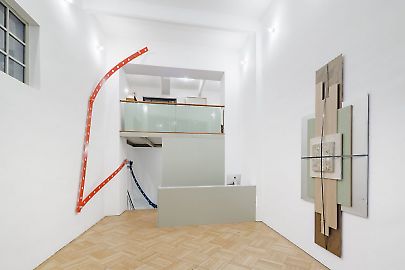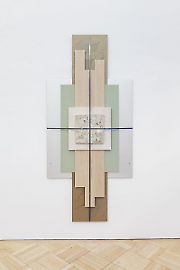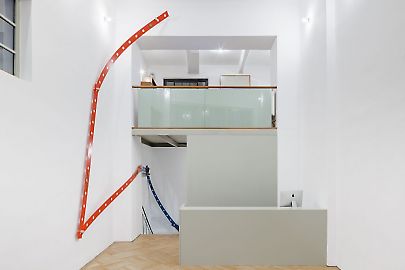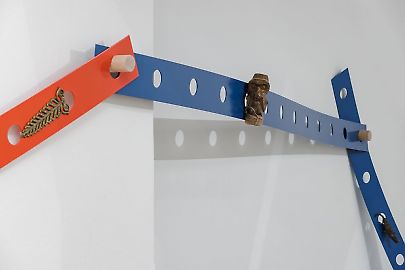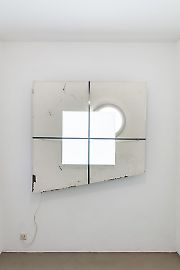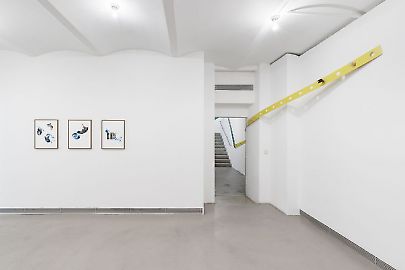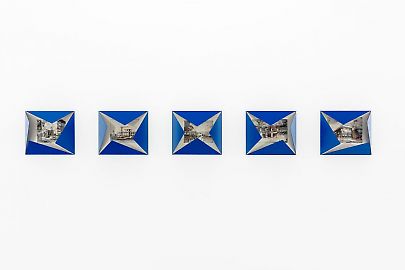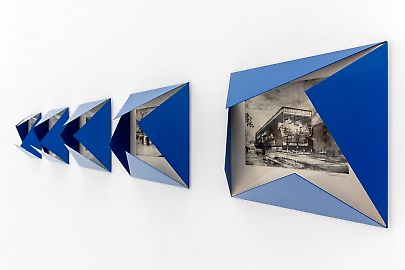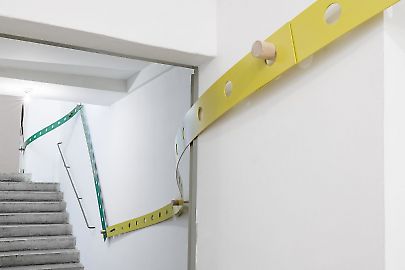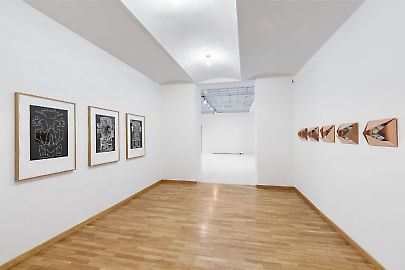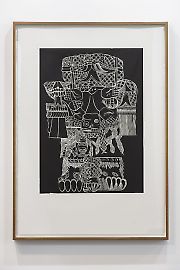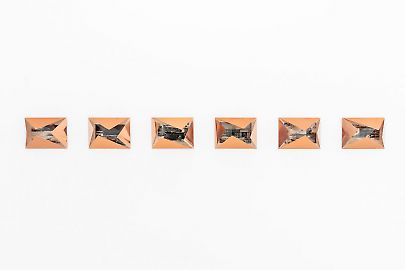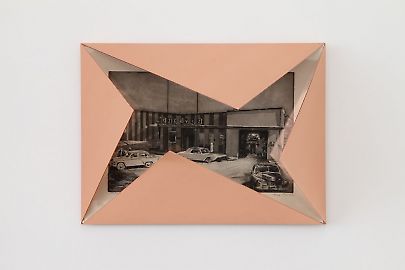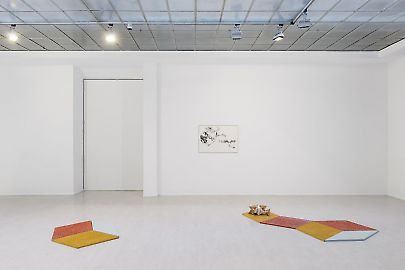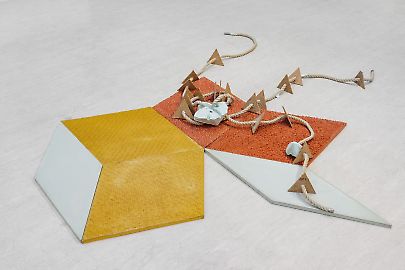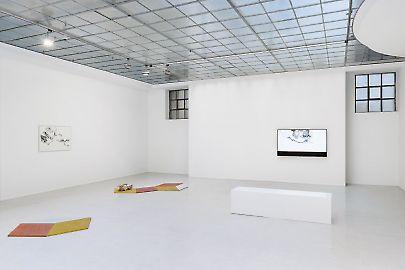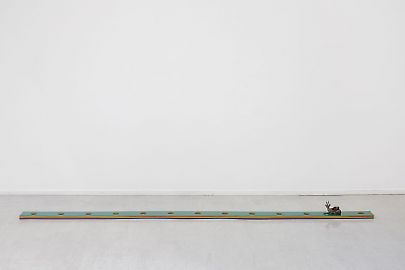Andreas Fogarasi and Mariana Castillo Deball -- Five Ways of Telling Time
Andreas Fogarasi und Mariana Castillo Deball
Five Ways of Telling Time
Five Ways of Telling Time presents sculptures, objects and videos by Mariana Castillo Deball and Andreas Fogarasi, in which processes of showing, uncovering, making visible again and engaging with transformation processes and their social, political and historical triggers play a central role. Starting from different thematic priorities, Fogarasi and Deball meet at many moments in their artistic practice: the exhibition seeks a sensitive dialogue between the works and illuminates these parallels. For Mariana Castillo Deball it is the first comprehensive presentation in Austria.
While Deball's starting point is often the work in and with archaeological and anthropological collections, in Fogarasi's case it is primarily the examination of architecture and the analysis of urban transformation processes that precede his works. Both begin with extensive research and analysis and translate these into formally reduced, coded and condensed visual languages. In addition, both artists move within the formal canon of contemporary art in a markedly reflective manner, addressing conceptual strategies as well as post-minimalist approaches in sculpture.
The artists' dialogue is structured by Deball's cross-room installation Tonalpohualli (2017), which runs throughout the gallery and along which visitors encounter the other works, including new “material portraits” and works from Fogarasi's Envelop series, works on paper by Deball, and two video works that are indicative of the artistic proximity but also the different approaches of the two.
A city like Vienna, which has been changing rapidly since the collapse of its socialist neighboring states after decades of stagnation, offers Fogarasi sufficient opportunities to study urban transformation processes and the mutual effects of social changes on the built environment and public space. In 2019 he presented his “material portraits” for the first time with the series Nine Buildings Stripped: he ensured components - surface cladding - of houses that were either redesigned or replaced by new buildings, tied them together with samples of the replacing materials with industrial packaging steel tape to form compact packages and hung them on the wall as images. They are portraits of transformation that, like a tilted picture, contain two identities and, in a paradoxical way, the past and the future. They are material, documentary and sculptural in one. The new works presented in the exhibition are freer in their conception: the tied-up materials no longer necessarily represent a specific building, but rather are typologically combined over time. The partial abandonment of the conceptual bracket of representing a specific building brings artistic freedom and emphasizes other sensual qualities always inherent in the hybrid material wall paintings. In these pictures the surface undergoes a kind of rehabilitation: it is seductive and eloquent, its colors, shapes and structures betray dreams and utopias of the time and the mental attitude that produced them. At the same time, they are reminiscent of images of early modernism, in which color and surface were freed from content for the first time and became an end in themselves, or of Minimal Art, since we have learned that every material has its own intrinsic value and is linked to a complex reference system. Not to forget that wood, stone, metal, ceramics, glass and plastics have their own origins and so a few million years of geological history are quickly combined in a tied package.
Another way of dealing with history and processes of transformation is the work of the Mexican artist Deball, who has been living in Berlin for many years, who often deals and negotiates with pre-Columbian history and the legacy of the advanced cultures of Central America against the background of current critical discourses such as the criticism of science and Postcolonial Studies.
So she dealt several times with illuminated manuscripts, so-called codices, of the Aztecs and Maya, most of which are still in European collections to this day. The sculptural installation Tonalpohualli refers to the Aztec calendar of the same name, which spans 260 days and shows the structure of the Aztec year in a square drawing. It is much more than a calendar: As a representation of the cosmic order and the world of gods, it played a central role in rituals, was consulted as an oracle and regulated all areas of life in society as a whole. Deball transfers the image of the Codex and the illustrated principle of order into the room, in an installation made of 20 industrially manufactured aluminum strips with 13 holes each. The structure reflects the division of the calendar into 20 13-day periods (Trecena), the colors symbolize the cardinal points. The length of the aluminum strips is 270 cm, a measure of length used in Aztec architecture and agriculture. Each Trecena is ruled by a different animal-shaped deity who sit as miniatures on the perforated metal strips connected with bolts. Like Fogarasi's material pictures, the structure is at the same time attached to its history and autonomous. With the translation of the Aztec picture calendar into a rational-abstract formal language, the artist builds a bridge from a past animated by deities and spirits to our present, from a pre-colonial to a post-colonial period.
The fact that the world of the gods was complex and varied and that it changed considerably over the centuries is expressed in three linocuts shown in the exhibition, which refer to the many ways of depicting Coatlicue, the goddess of the earth and death. Based on the original motifs, Deball transforms them into increasingly freer and more abstract forms.
Deball's interest in methods of reproduction and printing can also be found in Fogarasi, who has carried out a critical revision in his series Envelop (since 2019): Engraved Hungarian copper sheets from the 1960s are shown, which were in the then official style of socialist realism commissioned by the state and widespread by the state and have now disappeared from public visibility and esteem. The two series “Grand Socialist Constructions” and “Pictures from The Life of Hungarian Transport and Telecommunication” show Fogarasi's subtle play between showing and hiding but also his sensitivity in dealing with media and materials: the copper sheet of the display is reminiscent of the printing plates of the graphics.
In the last room, two videos are shown alternately on a monitor, Nobody was Tomorrow by Deball and a machine for by Fogarasi, both from 2007, in which they deal in very different ways with cultural institutions (library or cultural house) from the socialist era in Hungary and Serbia respectively.
Fogarasi's early video work already shows his interest in architectural surfaces, materials and forms that have been considered obsolete and discarded, as well as in the re-evaluation of buildings and their ideologies. The cultural centers of the socialist era are often empty today and are viewed as unloved relics of a bygone era. In a simple act of showing, the film conveys the progressive and socially utopian spirit of these institutions, which has been lost. The question of common places for culture and encounters is at least as relevant today as it was then.
Unlike Fogarasi's laconic documentarism, Deball's film is in the form of a dystopian science fiction story - it takes place after the disappearance of mankind - of the national library in Belgrade, a sprawling tree in the cultural center in the city of Cacak (Serbia) and the archaeological excavation of a Roman bath at the same place. All threads come together in the protagonist Nobody, a/withn aging acceleration machine.
Five Ways of Telling Time focuses on the inherent relationship to time in the works on view, presenting them as instruments, as five (or more) ways of describing the world.
- Bettina Spörr
Mariana Castillo Deball’s versatile practice explores the social relations that activate the differing meanings assigned to objects. Working along the margins of art, archaeology, anthropology and the natural sciences, her work draws on extensive research, tracing how epistemological systems interact to inform our shared identities and histories, in relation to the material world. Employing installation, performance, sculpture and printing, Deball’s work seeks to open a discourse with many institutions beyond the art world, to carve out how the ordering and archiving of historical information shapes individual and collective experience.
Mariana Castillo Deball (born 1975, Mexico City) lives and works in Berlin. She has been awarded with the Prix de Rome (2004), Zurich Art Prize (2012) and was nominated for the Preis der Nationalgalerie für junge Kunst (2013). Her work has been exhibited widely at institutions and museums internationally, including Centre Georges Pompidou, Paris; Hamburger Bahnhof – Museum für Gegenwart, Berlin; Stedelijk Museum, Amsterdam; Museum of Latin American Art (MOLAA), Long Beach; Institute of Contemporary Arts (ICA), London; Museu d’Art Contemporani de Barcelona (MACBA), Barcelona among others. She has taken part in numerous Bienales and major exhibitions including Documenta 14, Athens; 8th Berlin Biennale; Documenta 13, Kassel; 54th Venice Biennial, Venice; Manifesta 7, Trentino; 7th Shanghai Biennale, China, as well as her participation in the Mexican Pavilion at the upcoming 59th Venice Biennial.
Andreas Fogarasi (born 1977, Vienna) lives and works in Vienna. Particularly concerned with the act of showing and of representation, he analyses how places, cities, political ideas, or historic events become images and questions the role of culture in how the State regulates behaviour and identity. Formally informed by Minimal Art and Conceptual Art, Fogarasi’s works are at the same time documentary and autonomous sculptures. The documentary element is consciously fractured and rests on a precise balance between information and openness. The sculptural aspect is strongly architectural, often referencing iconic landmarks, commercial presentations or temporary forms of architecture such as stands at fairs, stage constructions, or pavilions.
Andreas Fogarasi has been awarded the Otto Mauer Prize in 2016 and won the Golden Lion for his exhibition in the Hungarian Pavilion at the 52nd Venice Biennale. His work has been presented at institutions in numerous countries: Kunsthalle Wien, Vienna; Museo Tamayo, Mexico City; Ludwig Museum, Budapest; New Museum, New York; Kunstverein für die Rheinlande und Westfalen, Düsseldorf; Muzej suvremene umjetnosti, Zagreb; CAC, Vilnius; Frankfurter Kunstverein, Frankfurt; and Palais de Tokyo, Paris.


